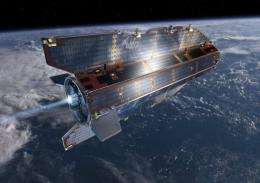European science satellite hit by glitch

A satellite designed to map Earth's gravitational field has been hit by a software glitch and is unable to send its science data back home, the European Space Agency (ESA) said on Monday.
The problem began to affect the spacecraft GOCE in late July, Mark Drinkwater, head of mission science at ESA's technical division, the European Space Research and Technology Centre (ESTEC), told AFP.
"The satellite's not transmitting its scientific data because of this anomaly," Drinkwater said from Noordwijk, the Netherlands.
Technicians were working on a patch and hope to install it by radio link next month, he said.
"All the other onboard systems are otherwise fine. We are not constrained by fuel or by time, and we have got excellent data in the bank already," Drinkwater said.
The satellite has already completed two-thirds of its mission and many science objectives have already been met, he said.
GOCE -- for Gravity field and steady-state Ocean Circulation Explorer -- was launched on March 17, 2009.
Its aim is to monitor tiny variations in Earth's gravity caused by ocean trenches, mountains and differences in density in the planet's interior.
Understanding these variations will have benefits in oceanography, especially in modelling complex ocean currents and predicting how sea will rise in response to global warming, ESA says.
The agency describes GOCE as "the Formula 1" of satellites because of its avant-garde design.
Whereas most satellites are essentially boxes, the five-metre (16.25-feet) craft is arrow-like and has stabilising fins because it orbits Earth at an altitude of just 250 kilometres (156 miles) where there is still a lingering atmosphere.
GOCE ran into a first problem in February this year when a chip failed in its primary computer. Ground engineers switched the satellite over to its backup computer.
The new problem is different from the first, being a software glitch in a module that deals with telemetry processing.
One approach is to stitch together the two computers' working parts so that the mission can recover, said Drinkwater.
GOCE is on ESA's roster of "Earth Explorer" projects to further fundamental understanding about the Earth.
Investigations into ice cover, soil moisture, ocean salinity, cloud cover, vertical winds and the planet's magnetic field are either planned or in operation.
(c) 2010 AFP




















